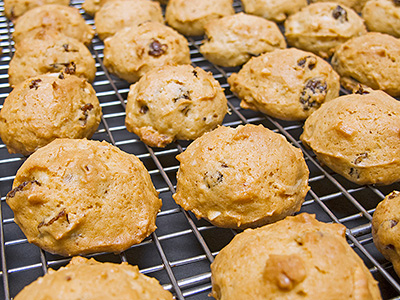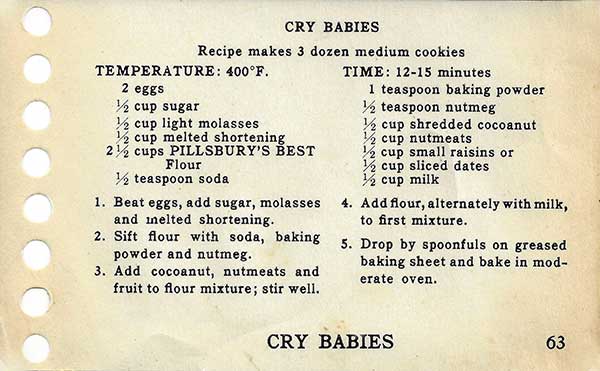June 23, 2014
Mignardise

pleurer les bébés
(cry babies)
I like old recipes. Maybe it’s an ego thing. Like I know something you don’t. Old recipes work for me. I know that when a recipe calls for pounding the sugar in a mortar and then sieving it, the recipe is from a time when sugar was purchased in solid loaves or cones. Pieces of sugar were “cut” from the cone or loaf using sugar scissors. If the cook wanted the equivalent of our granulated sugar, the pieces had to be pounded and then sieved. I know that flour wasn’t clean. It had to be sieved to remove bugs and stones. People still routinely sift flour today even though it no longer has bugs and stones. Why? Because the recipe instructs them to, or because they are unaware of history.
Recipes from the first half of the twentieth century are even simpler than earlier ones to decode. Depending on the decade, you may need to be aware of the effect of the home economics movement of the 1900s, voluntary rationing during the First World War, or the effects of the Great Depression on eating habits.
A while back, while researching banana-bread recipes for an earlier post, I stumbled across a cookbook published by the Pillsbury Flour Mills Company in 1933 called Balanced Recipes. Part of what makes this book interesting is its binding, or lack of a traditional binding. When the metal case that forms its covers is opened, an eleven-ring binder is revealed. Each recipe is on a three by five-inch piece of paper with eight holes that engage four of the rings. The binder is an early model for 1950s cookbooks where the recipes would be doled out as inserts in a magazine or food packages.

I opened the binder a few days ago to look for a recipe that a friend had requested. I didn’t find that recipe, but my curiosity was stirred by a recipe for a cookie called Cry Babies. This book was written before head notes became common. There’s no back story for the recipe in the book. A quick search on the Internet shows that there are lots of recipes for Cry Babies, but none quite the same as this one.
According to Bev Young in Presidential Cookies: Cookie Recipes of the Presidents of the United States, these cookies date back at least to the early nineteenth century: “The Monroes were from Virginia where Cry babies originated. The cookies’ curious name comes from a typical African tradition on plantations—to give vivid, unusual names to dishes and desserts. These cookies, which may have been baked for the Monroes, combine the richness of molasses with ingredients from an old English recipe.”
With a somewhat opposing view, Linda Stadley writes in her history of cookies on the website What’s Cooking America: “The English, Scotch, and Dutch immigrants originally brought the first cookies to the United States. Our simple butter cookies strongly resemble the English teacakes and the Scotch shortbread. The Southern colonial housewife of America took great pride in her cookies, almost always called simply tea cakes. These were often flavored with nothing more than the finest butter, sometimes with the addition of a few drops of rose water. In earlier American cookbooks, cookies were given no space of their own but were listed at the end of the cake chapter. They were called by such names as Jumbles, Plunkets, and Cry Babies. The names were extremely puzzling and whimsical.”
Rather than researching further, I decided to just try the Pillsbury recipe. As usual, I halved the recipe. I’m not a big molasses fan so I substituted brown sugar. My version makes about 42 cookies using a 1 tablespoon scoop.
50 g (1⁄4 c)
granulated sugar
50 g (1⁄4 c)
brown sugar
1 extra-large
egg, beaten
60 g (1⁄4 c)
melted shortening
25 g (1⁄4 c)
dried and shredded coconut
30 g (1⁄4 c)
sliced almonds
35 g (1⁄4 c)
sun-dried raisins, chopped
175 g (1-1⁄4 c)
all-purpose flour
1⁄4 t
baking soda
1⁄2 t
baking powder
1⁄4 t
ground nutmeg
60 ml (1⁄4 c)
whole milk
1. Preheat oven to 205 °C (400 °F).
2. Whisk the sugars into the egg. Whisk in the melted shortening. Whisk in the coconut, almonds, and raisins.
3. Combine the flour, baking soda, baking powder, and nutmeg in a bowl.
4. Switching to a wooden spoon or spatula, stir in the dry ingredients in three installments alternating with the milk in two.
5. Using a 1 T scoop, arrange mounds of dough on a baking sheet lined with a silicone pan liner or parchment paper. Allow enough space for each cookie to double in size.
6. Bake the cookies for about 12 minutes, or until the tops are light brown and the bottoms are a darker brown.
7. Cool the cookies on a rack.
© 2014 Peter Hertzmann. All rights reserved.
